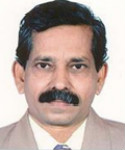| 个人简介 | |
|---|---|
 Prof. Athimoolam Sukumar National Council of Educational Research and Training, India |
|
| 标题: 'Human exposure assessment of element pollution for environmental health implications: Teeth as a biomonitoring tool’ | |
| 摘要: Out of 117 elements, almost 70% of them has been analyzed for various purposes in human teeth as an assessment tool of historical as well as modern exposures and also particularly in the place of bone for the bone seeking radioactive elements. Nowadays, the advanced analytical techniques available with quality assurance make tooth analysis a preferable biosample and also a complementary sample along with blood, urine, hair, nail etc. Reference or baseline values of tooth elements reflect the findings of element concentrations of teeth in a well-defined group of individuals, indicate their natural concentrations and become indispensable, if one is to interpret results generated for clinical utility; hence, a comprehensive compilation of literature survey is attempted to make available as a guideline for approximate concentrations of many elements of human teeth. A number of factors that are found influencing element analysis, are common to any biosample and broadly grouped under three categories, namely, characteristics of teeth, donor and technique of element analysis. In comparison of the references values of elements in teeth with the methods of tooth element measurement, how best the influencing factors to be considered, are discussed. So for as, several samples, hair and nails of Delhi, Tamil Nadu and Pondicherry subjects and teeth, blood, urine, hair, nail, water samples of subjects from Mysore and Bangalore, Karnataka, India have been analyzed for levels of multi-elements and occupational and environmental exposure profiles have been delineated with implication of Coronary Heart Disease, hypertension and diabetes and also other factors’ influences. Similarly, concentrations of multi-elements estimated throughout the world, in teeth and environmental samples are correlated with biomarkers of element effects to find out environmental health hazards of elements and etiology of certain diseases. Considering such utilities of tooth element analyses made in the samples of India and many countries around world, it is elaborately evaluated to identify the merits and demerits of tooth element investigation. There are many advantages which make teeth an attractive bio-analytical material; significantly they are easy to sample, to preserve and to store without the risk of any change in composition or contamination, since their composition changes more slowly than soft tissues in response to the factor due to a homeostatic mechanism which prevents either depletion or excess. The major limitation is that sampling is easy only from available subjects, but not from any specific subjects who could not donate immediately one or as and when required. Except this hurdle, the viewed is that teeth are a practically valuable biopsy material for environmental health monitoring of population. Keywords: Environmental health monitoring, Elements, Human teeth, Reference values, Element exposure | |
| 简介: Ph.D. (1990) in Environmental Toxicology from Jawaharlal Nehru University, New Delhi. Since 1988, having experience in teaching the subjects of environmental science, physiology, cyto-genetics, immunology, ethology to undergraduate and post graduate students. From 1985 doing research work related to environmental toxicology, epidemiology and health; presently working on the following research areas of studies: Human exposure assessment of trace elements, radioactive elements, through biomonitoring of human samples (blood, urine, milk, saliva, teeth, hair, nails, and autopsy samples) for Cr from tannery effluent, Hg from seafood, Pb, Cd, Hg and radioactive elements from industrial and traffic air pollution and health implication. Influence of elements and assessment of nutritional status of Cr, Cu, Mn, Zn, V & Se among diabetic, hypertensive and cardiovascular patients for supplementation. Analysis of Pb, Cd, Hg, As, Cr, Cu, Mn, Zn, V & Se in the water and food (edible oils, milk, beverages, vegetables, fruits, meat etc.) for element sources from food and health implication. Analysis of elements and biomarkers of carcinogens of environmental origin and tracing causes of cancers. Radon analysis and its health implication in Bangalore city, India. Worked as a Principal, North East Regional Institute of Education, (NERIE), Shillong, for five years from July 2012 to July 2017; presently working as a Professor in Zoology and the Head of Education in Science and Mathematics, Regional Institute of Education (RIE). Visited abroad for participating and presenting research papers in the International conferences held in Paris (1998), Torino (Italy, 2008), Belgrade (Serbia, 2010) and Colombo (Sri Lanka 2017). Worked as a visiting fellow for one month at Laboratory of Biochemistry, Toxicology, Fernand Widal, Paris for the work of analysis of food samples of diabetes of south India for status of trace elements (Cr, Cu, Zn,V & Se). Consultancy services have been rendered for developing gallery with the theme of environmental conservation in Regional Museum of Natural History, Dept. of Environment and Forest, Govt. of India, Mysore. Guiding a few research scholars of M.Phil. and Ph.D. and a few of them were awarded degrees. Research project related to environmental education: Two completed. Research articles published: 30, International: 17 & National: 13 including 2 review articles (Springer) & a contributed chapter in Encyclopedia of Environ. Health (Elsevier). Books published: 3 (one in Education and two proceedings of national seminar). Conferences attended and articles presented: 10 National and 8 International conferences. Invited lectures delivered and chaired session of National and international conferences. National Seminars organized: Two in 2008 at RIE, Mysore and in 2014 at NERIE Shillong and their books of abstracts and full papers were published. Research articles have been reviewed for about five international science journals. Life member of Science Association in India: Three (Indian Science Congress Association, Society of Toxicology, India and Indian Association of Physiologists and Pharmacologists of India). Member of 1) Executive and management committees, 2) Advisory and academic committees of state Government Education Departments and organizations. | |
